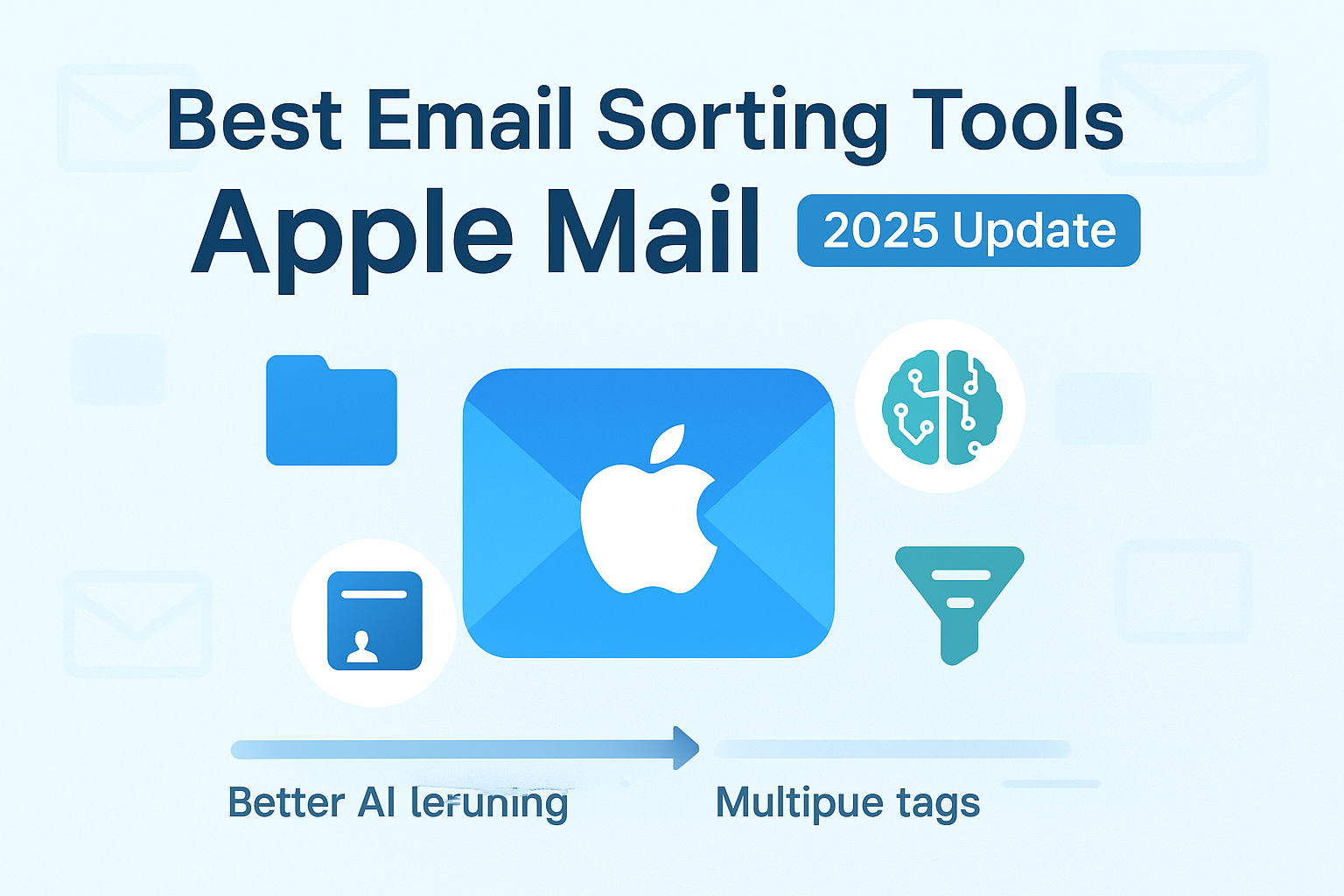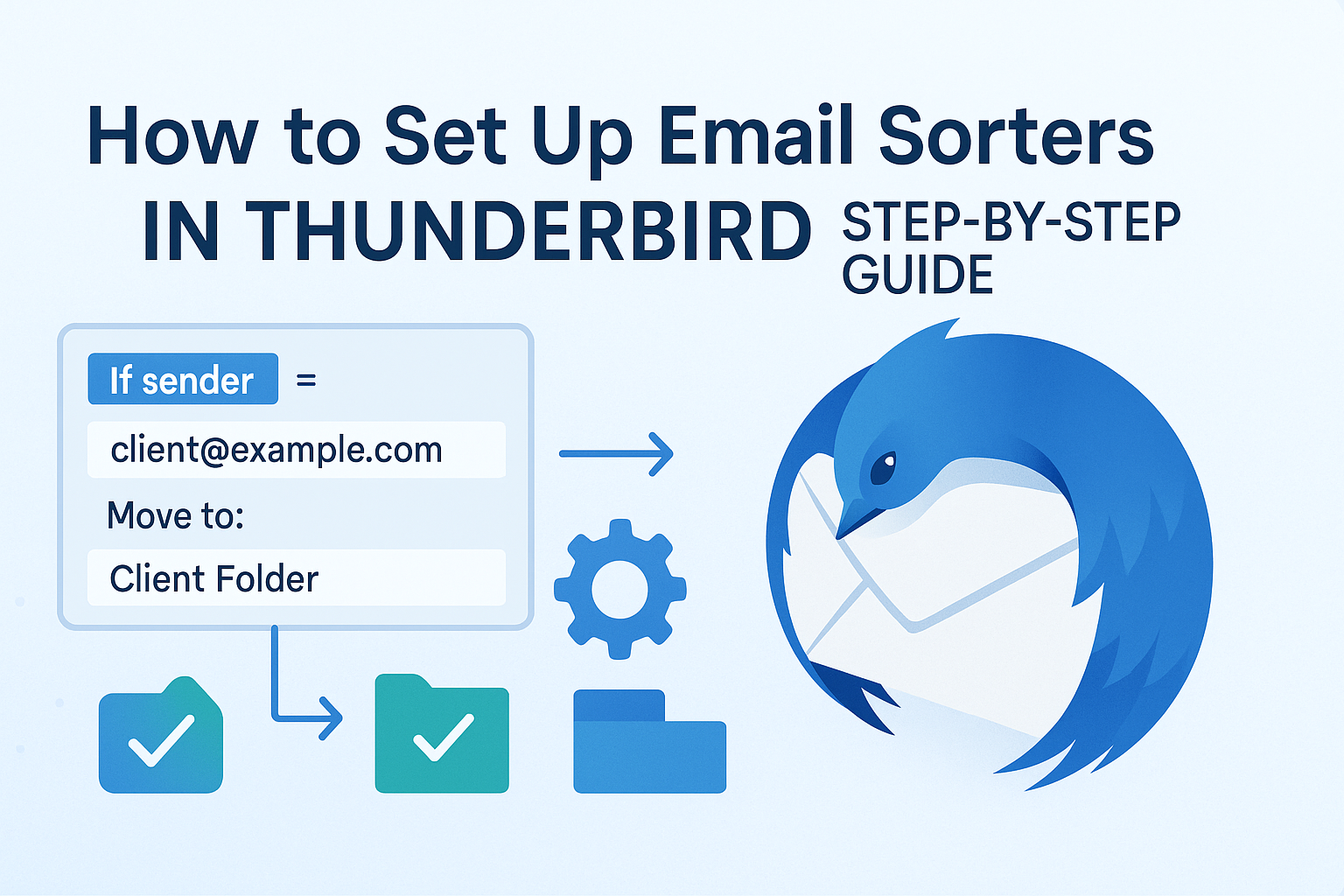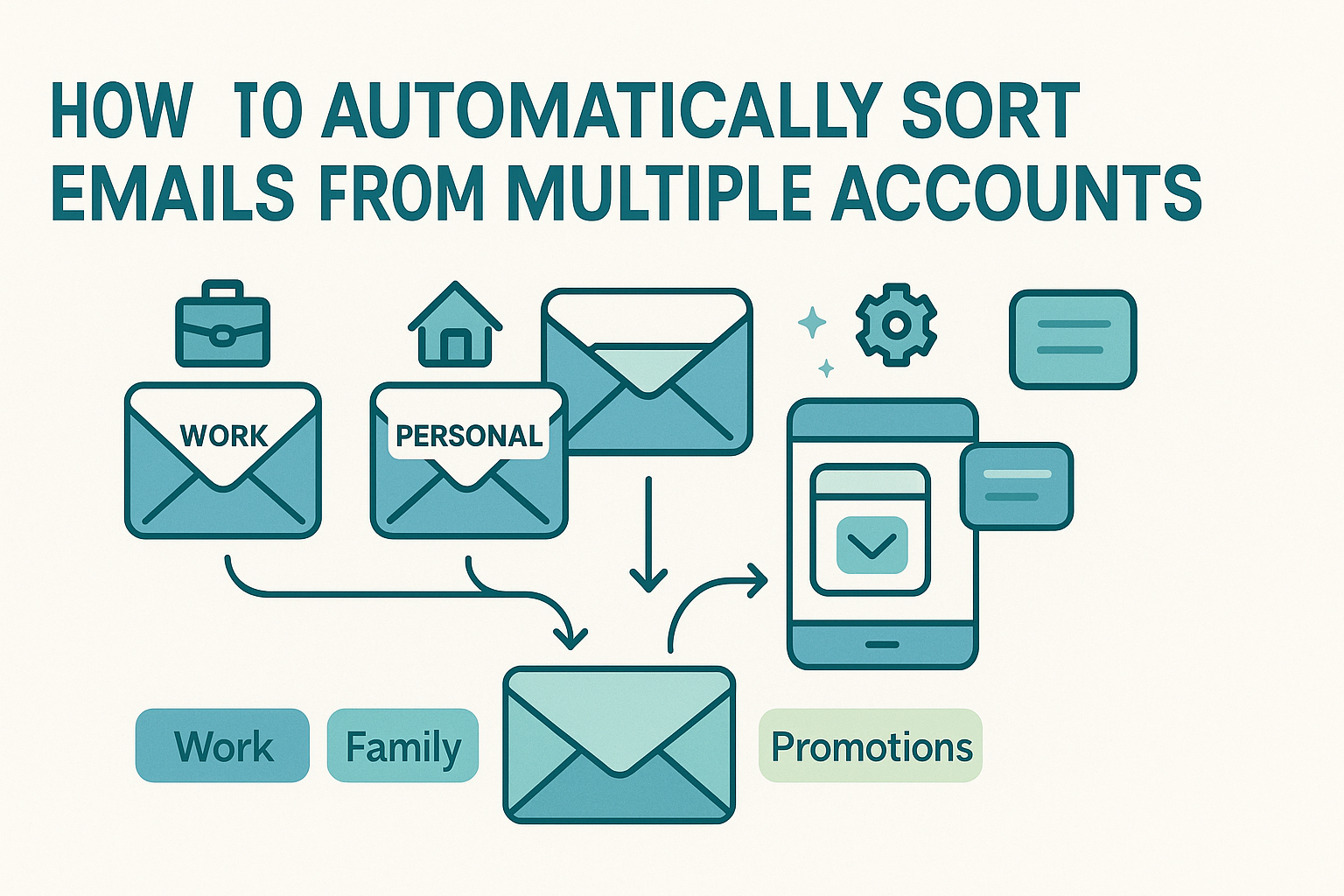Email Sorting Tools for Apple Mail can change the way you manage your inbox in 2025. Do you feel overwhelmed by emails on your Mac, iPhone, or iPad? You’re not alone. Apple Mail has a clean design, but its built-in tools often fall short when dealing with daily email chaos.
Imagine having a smarter system that sorts, labels, and organizes your emails without effort. Email sorting tools for Apple Mail help you keep your inbox clean, save time, and focus on what matters most.
This guide shares the best email sorting tools for Apple Mail. You’ll find options that work well with macOS, are easy to use, and sync across all your Apple devices. Ready to take control of your inbox and make email simple again? Let’s get started.
Email Sorting on Apple Mail: What Works and What’s Missing
Apple Mail has made incremental improvements over the years, but many of its sorting features remain underwhelming by modern standards. At its core, Apple Mail allows users to create basic rules—like moving messages from certain senders into folders, marking emails with flags, or applying color-coded categories. These features work well for straightforward tasks but lack the depth required to handle nuanced workflows or high email volumes.
One useful native feature is the VIP list, which allows users to prioritize messages from specific contacts. Another is flagging, which provides a visual way to mark emails for later attention. However, these tools require constant manual input and don’t adapt over time. For example, Apple Mail doesn’t learn from your behavior or improve based on your labeling habits. There’s no built-in AI or machine learning engine to help surface important messages or suppress irrelevant ones.
These limitations push many users to explore third-party solutions. External tools bring advanced sorting options, such as dynamic rules, automatic categorization, spam suppression, and smart labeling. They also allow you to manage inboxes across multiple devices in real time—an area where Apple Mail alone can struggle.
To help you get started with this shift, especially if you’re unsure how to configure these tools on macOS, take a look at our complete Mac setup guide. It walks through the process of installing and syncing email sorters with Apple Mail, ensuring everything works smoothly from day one.
Top Sorting Tools Fully Compatible with macOS
Several third-party tools now offer full support for Apple Mail on macOS, and many integrate directly into your existing inbox without requiring a new email client. These tools are built to work seamlessly with the Apple ecosystem, preserving the user experience while drastically improving functionality.
Clean Email is one standout option. It allows users to organize email in bulk with automation powered by intelligent rules. You can sort messages based on sender, subject, or content, and set up recurring actions for newsletters, receipts, and system alerts. SaneBox is another favorite among professionals—it adds intelligent filtering directly to your Apple Mail interface and moves low-priority messages into separate folders like “SaneLater” or “SaneNews.” You can also train it over time by dragging messages between folders.
Mailbutler is ideal for users who want sorting and productivity tools in one place. In addition to email classification, it adds features like follow-up reminders, templates, and even email tracking. It lives inside Apple Mail and offers real-time syncing across devices, which is critical for users who check email on multiple platforms.
These tools don’t just enhance Apple Mail—they elevate it. By automating repetitive tasks, learning from your habits, and giving you real-time control over inbox priorities, they help you shift from reactive email management to proactive organization.
Cross-Platform Integration: Mac to iPhone and iPad
One of Apple’s greatest strengths is its seamless ecosystem—and any sorting tool worth using should match that level of integration. When choosing an email sorter for Apple Mail, cross-platform functionality isn’t a luxury; it’s essential. After all, most users don’t just check their email on a Mac. They triage messages on an iPhone during commutes, scan updates on an iPad while multitasking, and process deeper tasks on a desktop.
That’s why the best email sorting tools go beyond basic macOS compatibility. They offer real-time syncing across your Apple devices, ensuring that the rules and preferences you apply on your Mac are reflected instantly on your iPhone or iPad. Tools like Clean Email and SaneBox stand out here—once configured, your inbox maintains consistent logic no matter where you check it from. If you move a promotional email into a “Read Later” folder on your iPhone, that same message is handled the same way on your Mac.
This level of synchronization is particularly important for business users, where even a small inconsistency can lead to missed opportunities or redundant sorting. Whether you’re assigning labels, archiving newsletters, or tagging invoices, your email behavior should carry over without friction.
For those looking to optimize this multi-device experience, check out our comprehensive guide on how to sync across devices. It covers the key steps to unify your inbox logic between macOS and iOS, ensuring every device stays in lockstep with your email workflow.
iPhone-Ready Email Sorting Tools
Mobile performance is no longer optional. If a sorting tool works great on your Mac but leaves you scrambling on your iPhone, it’s not the right fit for the Apple ecosystem. Today’s top email sorters come with robust iOS apps or seamless mobile extensions that work directly with Apple Mail, giving you control and automation wherever you are.
SaneBox, for example, doesn’t require a separate app. It runs in the background, applying smart filters to your Apple Mail account that sync across your devices. This makes it ideal for users who want invisible automation that just works. On the other hand, Clean Email does offer a dedicated iOS app with full access to its sorting rules, cleaning functions, and analytics dashboard. You can review and update rules, manage folders, and even set filters from your iPhone with just a few taps.
This kind of mobile access is vital for users who manage inboxes on the go. Whether you’re flying, commuting, or just stepping away from your desk, being able to tag, archive, or filter email from your iPhone keeps your sorting system running smoothly.
To explore more solutions that thrive in a mobile environment, take a look at our curated list of mobile apps built specifically for email sorting on iPhone and Android. These tools are designed with mobile usability in mind, offering speed, clarity, and reliability—exactly what Apple users expect.
Budget-Friendly & Freemium Options
Not every Apple Mail user needs an enterprise-level email sorting system. For many, a lightweight tool that handles clutter and automates basic workflows is more than enough. Thankfully, the 2025 market offers several affordable and even free options that integrate well with Apple Mail while maintaining strong core functionality.
Clean Email is a standout here, offering a generous free trial and a freemium tier that includes basic smart filtering, email grouping, and privacy controls. It’s an excellent option for users who want to explore automation without committing to a monthly subscription. SaneBox also offers limited functionality during its trial period, allowing users to experience the benefits of AI-based filtering before upgrading.
For users primarily focused on managing newsletters, subscriptions, or basic labeling, tools like Chuck or Spark’s native sorting features can serve as minimal, no-cost solutions. These work particularly well for individuals or small teams who don’t need deep AI training or enterprise syncing.
When exploring these more affordable tools, it’s important to weigh long-term functionality against short-term savings. Free tiers often limit access to deeper features like advanced filtering or rule-based triggers—but they can still deliver immense value if your sorting needs are basic.
To see how the top freemium options compare side by side, take a look at our detailed breakdown of the free sorters available today. It’s a great starting point for budget-conscious users who still want a smarter inbox without the financial commitment.
Best Tools for Ease of Use
Apple users value simplicity. That’s why user experience plays a huge role in choosing the right sorting tool for Apple Mail. A cluttered interface or confusing setup process can be a dealbreaker, even if the software is technically powerful.
Fortunately, many developers have leaned into Apple’s design language, building sorting tools that feel native to macOS and iOS. Clean Email’s interface, for instance, is built around clarity. You can view all email groups, set filters, and adjust settings within a clean, distraction-free dashboard. Likewise, Mailbutler’s plug-in fits neatly into Apple Mail without crowding the interface or overcomplicating daily use.
For users who aren’t especially tech-savvy—or who just want something that “just works”—these intuitive platforms are a perfect fit. They allow drag-and-drop rule creation, one-click tag management, and clear feedback on what’s being sorted and why.
Conclusion
As Apple Mail continues to be the preferred choice for millions of Mac, iPhone, and iPad users, it’s clear that third-party email sorting tools have become essential for taking control of the modern inbox. While Apple Mail offers a clean, minimalistic foundation, it lacks the smart automation, AI capabilities, and multi-device rule syncing that professionals and productivity-focused users demand.
The tools highlighted in this guide—from powerful platforms like Clean Email and SaneBox to the flexible features of Mailbutler—bring advanced sorting functionality to Apple’s native email client without disrupting its sleek interface. Whether your priority is intelligent spam control, smart labeling, or seamless sorting across all Apple devices, there’s a solution built for your needs.
By matching the right tool to your personal workflow—based on platform, price, simplicity, or sync—you’ll finally gain an inbox that works with you, not against you.
Frequently Asked Questions
Do I need third-party tools if I already use Apple Mail rules?
Apple Mail’s built-in rules can handle basic sorting, but they lack the intelligence, adaptability, and automation found in third-party tools. If your needs go beyond sender-based filters or simple folder moves, a more robust tool will greatly enhance your inbox experience.
Are sorting tools safe to use with personal or work accounts?
Yes, most reputable email sorting tools use strong encryption and privacy standards. Services like SaneBox and Clean Email are GDPR-compliant and offer transparent data handling policies. Always review security settings during setup to ensure your data stays protected.
Will these tools work on older macOS versions?
Most tools support at least the last two or three major macOS versions, though some advanced features may require macOS Monterey or newer. Always check the tool’s compatibility notes before installing to avoid feature limitations.
Can I use the same sorter across both my Mac and iPhone?
Yes, the best sorting tools offer full sync between macOS and iOS. Once set up, your labels, folders, and rules will apply across all devices. For detailed setup tips, see our article on sync across devices.
What’s the easiest way to set up email rules on a Mac?
Start with Apple Mail’s built-in rule settings for basic filtering, then enhance them using a dedicated tool. If you’re unsure where to begin, our Mac setup guide walks through the steps to get your sorting tool connected, configured, and optimized for everyday use.




